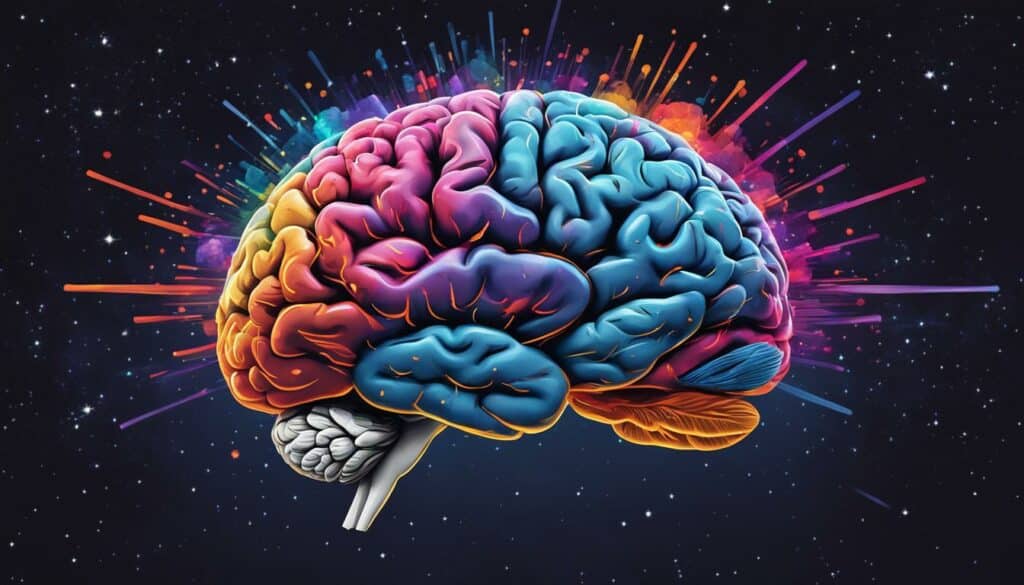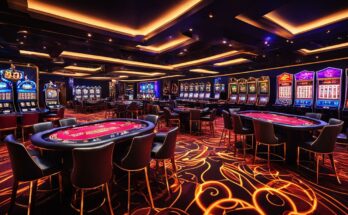Do you ever find yourself waking up to the sound of laughter? Sleep laughing, also known as hypnogely, is a phenomenon that many people experience. It occurs when laughter happens during sleep, usually in response to a funny or amusing dream. But just how common is sleep laughing?
According to studies, sleep laughing is quite prevalent. Research has shown that a significant percentage of both children and adults have reported experiencing sleep laughing at least once. For example, one study found that 33-44% of middle school children and 73% of undergraduate students have encountered sleep laughing during a specific period of time. While most cases of sleep laughing are harmless, it could also be indicative of an underlying sleep disorder or neurological condition.
Key Takeaways:
- Sleep laughing, also known as hypnogely, is a common occurrence during sleep.
- It is believed to be a response to funny or amusing dreams during the rapid eye movement (REM) sleep stage.
- Studies have shown that sleep laughing can happen frequently, with a significant percentage of people experiencing it at least once.
- While sleep laughing is usually harmless, it can also be a symptom of sleep disorders or neurological conditions.
- If sleep laughing is accompanied by other symptoms or causes distress, it is advisable to consult a healthcare professional for further evaluation.
Causes of Sleep Laughing
Laughing during sleep, also known as sleep laughing or hypnogely, can be attributed to various factors. Understanding the causes behind this phenomenon can shed light on the frequency and incidence of sleep laughing episodes.
Humorous or Odd Dreams
Sleep laughing is most commonly triggered by having a humorous or odd dream. During rapid eye movement (REM) sleep, which is the stage of sleep associated with vivid dreaming, the brain may interpret dream content as funny, resulting in laughter. Sleep partners often report hearing their bedmates chuckling or giggling during sleep, indicating the influence of dream experiences on sleep laughing frequency.
Timing and Sleep Stages
Sleep laughing is more likely to occur during the second half of the night. As sleep progresses, the duration and intensity of REM sleep increase, creating a ripe environment for laughter during sleep. It is worth noting that sleep laughing can sometimes wake the individual up, interrupting the sleep cycle.
Stress and Anxiety
Stress and anxiety experienced during the waking hours can manifest as laughter during sleep. In some cases, the brain may release built-up tension or express emotional release through laughter while asleep. This laughter provides a temporary reprieve from stressors, allowing for a more peaceful sleep experience.
Sleep Disorders and Neurological Conditions
Sleep laughing can also be a symptom of sleep disorders and neurological conditions. REM behavior disorder (RBD) is a sleep disorder characterized by the absence of muscle paralysis during REM sleep, leading to physical movements and behaviors associated with dreams. In rare cases, sleep laughing can be associated with gelastic seizures, which are uncontrolled bouts of laughter caused by certain neurological conditions.
Medications and Genetic Factors
Specific medications, such as certain antidepressants or antipsychotics, may influence sleep laughing incidence. Furthermore, genetic factors may contribute to an individual’s susceptibility to sleep laughing. Further research is needed to understand the precise genetic and medication-related mechanisms that influence sleep laughing frequency rate.
https://www.youtube.com/watch?v=dnRTt34wAhk
Understanding the causes of sleep laughing provides valuable insights into its occurrence and prevalence. The table below summarizes the main causes discussed:
| Cause | Description |
|---|---|
| Humorous or Odd Dreams | Laughing at funny or peculiar dream content |
| Timing and Sleep Stages | More likely to happen in the second half of the night during REM sleep |
| Stress and Anxiety | Laughter as a release of tension during sleep |
| Sleep Disorders and Neurological Conditions | Associated with conditions like REM behavior disorder or gelastic seizures |
| Medications and Genetic Factors | Influence of certain medications and individual genetic predispositions |
Sleep Laughing and REM Sleep
Sleep laughing, also known as hypnogely, is most commonly experienced during the stage of sleep known as rapid eye movement (REM) sleep. REM sleep is the stage of sleep where dreaming occurs and is characterized by heightened brain activity and muscle paralysis in the body. During REM sleep, individuals are unable to physically act out their dreams due to this paralysis.
However, in some cases of REM behavior disorder (RBD), the muscle paralysis is absent, allowing for physical movements and behaviors associated with dreams, including laughter. RBD is a sleep disorder characterized by abnormal physical activity during sleep, which can include sleep laughing. According to sleep laughter statistics, RBD is more common in older males, particularly those with neurological conditions like Parkinson’s disease or multiple system atrophy.
It’s important to note that while sleep laughing is often harmless and a normal part of REM sleep, it can also be a symptom of underlying sleep disorders or neurological conditions, such as RBD. If you or a loved one experiences frequent or disruptive sleep laughing, it’s advisable to consult a healthcare professional for proper diagnosis and treatment.

Sleep Laughing in Babies
Laughing during sleep is a common and delightful phenomenon observed in babies, especially during REM sleep. It is considered a normal and harmless occurrence, often an expression of positive dream content. Babies have a natural reflex to smile, laugh, and make various facial expressions while sleeping, indicating their emotional and sensory experiences during slumber. This sleep laughter is commonly observed in infants and young children, bringing joy and warmth to their parents.
Although sleep laughing in babies is usually not a cause for concern, it is essential for parents and caregivers to be attentive to any accompanying unusual behaviors or frequent awakenings. While infrequent laughter during sleep is considered normal, persistent and excessive laughter, along with other irregularities, may warrant a discussion with a healthcare professional to rule out any underlying medical conditions. It is always better to be cautious and seek professional guidance when in doubt about a baby’s well-being.
The Benefits of Sleep Laughter in Babies
Laughter is a universal language of joy, and it plays a crucial role in the healthy development of babies. Sleep laughter offers various benefits, including:
- Promoting Emotional Well-being: Laughter during sleep helps babies release tension and promotes a positive emotional state, contributing to their overall well-being.
- Strengthening Bonding: When babies laugh during sleep, it can bring joy to their parents or caregivers, fostering a deeper bond and strengthening the parent-child relationship.
- Enhancing Cognitive Development: Sleep laughter stimulates brain activity, aiding in the development of cognitive functions such as memory, problem-solving, and creativity.
- Encouraging Physical Development: Laughing during sleep can activate various muscles in the face and body, contributing to the development of motor skills.
Providing a loving and nurturing environment for babies to sleep and dream is essential, as it paves the way for their healthy growth and development. So, cherish those sweet sleep giggles and understand that they are a natural part of your baby’s sleep journey.
Understanding REM Sleep and Sleep Stages
REM sleep, also known as Rapid Eye Movement sleep, is a crucial stage of the sleep cycle. It is characterized by rapid eye movements, vivid dreaming, and temporary muscle paralysis. During REM sleep, the brain activity is similar to when we are awake, while the body experiences muscle atonia, a state of paralysis that prevents us from physically acting out our dreams.
REM sleep plays a vital role in memory consolidation, learning processes, and emotional regulation. It is during this stage that our brains process and organize new information, helping us retain memories and improve cognitive functions.
REM sleep occurs multiple times throughout the night, interspersed with non-REM sleep stages. Non-REM sleep consists of four stages: Stage 1, Stage 2, Stage 3, and Stage 4. Each stage has distinct characteristics and serves different functions in the sleep cycle.
| Sleep Stage | Characteristics |
|---|---|
| Stage 1 | Transition stage between wakefulness and sleep. The body starts to relax, and brain activity slows down. |
| Stage 2 | Deeper sleep stage. Brain waves continue to slow down, and the body enters a state of deep relaxation. |
| Stage 3 | Deep sleep stage. Brain waves become slower, and the body experiences further relaxation. It is difficult to wake up from this stage. |
| Stage 4 | Deepest sleep stage. Also known as delta sleep or slow-wave sleep. Brain waves are at their slowest, and the body is fully relaxed. It is most challenging to wake up from this stage. |
| REM Sleep | Rapid eye movements, vivid dreaming, and temporary muscle paralysis. Brain activity is similar to that when awake, while the body remains in a state of paralysis. |
During REM sleep, most of our dreams occur. It is a time of intense brain activity, creativity, and emotional processing. However, some individuals may experience a disruption in REM sleep due to a condition called REM sleep behavior disorder (RBD).
REM Sleep Behavior Disorder (RBD)
“REM sleep behavior disorder is a sleep disorder where individuals do not experience the usual muscle paralysis during REM sleep, resulting in physical movements and behaviors associated with their dreams.”
RBD involves acting out dreams physically, which can lead to actions such as talking, shouting, or even violent movements during sleep. This disorder is more common in older males, particularly those with underlying neurological conditions such as Parkinson’s disease or multiple system atrophy.
Understanding the different stages of sleep, including REM sleep, can help us comprehend the complex processes that occur during the night. A healthy sleep pattern with sufficient REM sleep is essential for overall well-being and optimal cognitive function.

Conclusion
Sleep laughing is a relatively common and usually harmless phenomenon that occurs during sleep. It is often a result of laughing at dreams during REM sleep, the deepest stage of sleep where dreaming takes place. Sleep laughing is more likely to happen in the second half of the night.
While most cases of sleep laughing are normal and do not require treatment, it can also be associated with sleep disorders like REM behavior disorder (RBD) or neurological conditions. If sleep laughing is accompanied by other symptoms or causes distress, it is important to consult a healthcare professional to determine the underlying cause and appropriate treatment, if necessary.
If you or a loved one experiences sleep laughing, it’s essential to pay attention to any additional symptoms or changes in sleep patterns. Keeping a sleep diary and monitoring the frequency and intensity of sleep laughing can provide valuable information for healthcare professionals. Remember, understanding the underlying cause of sleep laughing can help ensure a good night’s sleep and overall well-being.
FAQ
Is sleep laughing common?
Yes, sleep laughing, also known as hypnogely, is a common occurrence during sleep.
What causes sleep laughing?
Sleep laughing is usually caused by laughing at a dream during rapid eye movement (REM) sleep. It can also be a result of humorous or odd dreams.
How frequently does sleep laughing occur?
Sleep laughing can happen frequently, with one study finding that 33-44% of middle school children and 73% of undergraduate students reported experiencing sleep laughing at least once in a certain period of time.
Is sleep laughing associated with any sleep disorders?
Sleep laughing can be a symptom of sleep disorders such as REM behavior disorder (RBD) or gelastic seizures.
Does sleep laughing happen during REM sleep?
Yes, sleep laughing predominantly occurs during REM sleep, which is the stage of sleep where dreaming takes place.
Is sleep laughing common in babies?
Yes, sleep laughing is very common in babies, particularly during REM sleep.
What is REM sleep?
REM sleep is a stage of sleep characterized by rapid eye movements, vivid dreaming, and temporary muscle paralysis.




